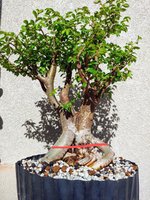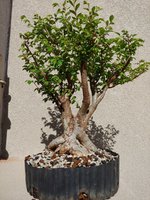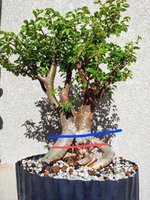luvinthemountains
Chumono
I picked this elm up recently on FB. I was excited to see an elm that isn't in a typical import "broom" style. But I knew from the get-go that the roots would be a challenge. Not sure how they got this way, but it's a mess. Big fat tuber on one side, a smaller tuber swooping around the other side, and then this twist of fused roots in the middle that wouldn't be that bad on their own, but cutting off the other two would leave me with big scars and nasty inverse taper.
What I am thinking I will do is plant the tree deeper and grow a new and (hopefully) improved root base. There are two ways I could do this: (1) cut a girdle all the way around and use a deeper pot to ground-layer right now; or (2) grow it hard this growing season, then cut it off at the red line next spring and plant it as a big cutting. Advice?

Other side:

What I am thinking I will do is plant the tree deeper and grow a new and (hopefully) improved root base. There are two ways I could do this: (1) cut a girdle all the way around and use a deeper pot to ground-layer right now; or (2) grow it hard this growing season, then cut it off at the red line next spring and plant it as a big cutting. Advice?

Other side:


